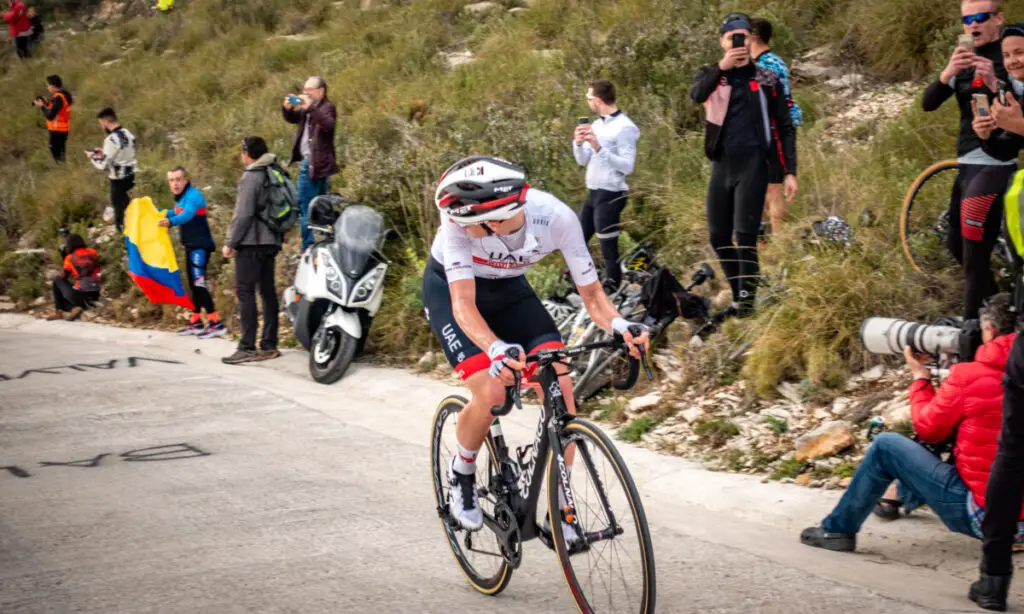A base layer is one of the most underrated pieces of cycling clothing! It’s one of those things you don’t think about when you start cycling, but after a few hundred miles done, it’s going to find a way into your wardrobe.
A base layer is an undershirt made from synthetic material. Its main job is to wick away the sweat and thus manage the moisture. On a hot day, it prevents body overheating and on a cold day, it keeps you warm. Many cyclists also wear it as an extra layer of protection in case of a crash.
Cyclists are not uniform about the usability of a base layer. Some love it, others don’t like it at all. Even on a professional level, there are differences of opinion. Below I will tell you why I think the base layer is useful and why you should definitely own it.
What is a base layer?
Have you ever seen a middle-aged man with a hairy chest and a bit of stomach going uphill fully unzipped? Yeah, it’s not a pretty sight. He should definitely wear a base layer.
On a more serious note, a base layer is not only used to hide your skin when riding unzipped. It’s much more than that.
A base layer is an undershirt that you wear under your jersey. It comes in all shapes and sizes, but synthetic base layers with short sleeves or no sleeves are the most common. On warmer days, the string vest (Amazon) is a popular choice, while on cold days, many cyclists use a base layer made from merino wool.

A quality base layer doesn’t need to cost much. You can find many good deals on Amazon. My recommendation for the summer is a sleeveless base layer by Santic, and for the winter rides Castelli’s base layer with short sleeves.
The thermoregulation is a big aspect of a base layer, but more on that a little later. First, I want to tell you why you should definitely use the base layer and what is the main advantage of having one.
The main point of a base layer is to wick away the sweat. “How?” you might ask. Well, it’s made of synthetic material, which is very good at taking care of sufficient airflow. The sweat, therefore, doesn’t stay on your body, so you don’t waste the energy to evaporate the sweat. The base layer does that for you.
By using a base layer, you completely avoid an over-soaked jersey that absorbs all the sweat and then dries on you. This is one of the most unpleasant feelings, as you can even get cold despite the high temperature outside.
Why use a base layer on a cold day?
If you’re brave enough to cycle outside even when the temperature drops, you know that you need to dress appropriately. Every extra layer of clothing will help in the battle against the cold. But will it really?
Sure, every layer will keep you warmer, but only for a short time. If you choose the wrong clothes, they can actually keep you cold.
When you’re involved in an activity outside on a cold day, you have to put on the right pieces of clothing. Cotton T-shirts or any other pieces that don’t breathe will only cause you problems once they get soaked from sweat.
The first place people start to sweat is on their backs. On a bike, you’re in a position where the shirt on your back is constantly tight against your body. The backside of the shirt gets wet and with cold air flowing over it, it is only a question of time before you catch a cold.
A base layer efficiently solves this problem. Due to the material used it keeps the sweat away from your body and keeps you much warmer.
Tight base layers also give you a cozy feeling as they hug your body and don’t let the cold air get to your body. That’s especially important on descends, thou even with a base layer, I still recommend using a vest when going downhill.
My preferred material for cold days is merino wool. It’s one of the most comfortable materials on a planet and still very good at wicking the sweat. However, since merino is wool, it’s quite warm, so if the temperature is not that low or if you’re someone that gets hot easily, then you might want to use something less warm.
My recommendation for the winter base layer is Castelli short sleeve base layer.
Why use a base layer on a hot day?
If the use of a base layer on cold days is mostly clear, many find it harder to understand why they would wear it on hot days.
So, let me explain.
A base layer can actually keep you colder on a hot day. How? By wicking away the sweat it helps regulate body temperature and prevent it from overheating.
Sure, you need a bit of common sense when choosing a base layer for a hot day. Don’t go with merino wool, as you would actually get much warmer. Use a base layer with no sleeves or even a string vest, which is a popular choice among cyclists.
During research for this article, I did a poll with over 69 cyclists, asking them if they wear a base layer during summer. Two-thirds of them answered YES, with a few explaining that their preferred choice is a string vest.

The debate whether to use a base layer in the summer or not is a heated one and there will always be some people that will be against it. That’s okay, but let me explain some more, why I recommend you use it even when the sun is burning.
Most cyclists that are against it say that the jersey already wicks the sweat away, at least the good ones. While this is true to some degree, jerseys also have quite a few other jobs to do, so the manufacturers need to compensate quite a bit.
A beautiful jersey doesn’t wick away the sweat. A jersey that is good at sweat control doesn’t look that nice. I want to say that jerseys have many other functions that need to be taken into account when produced, so sweat control often suffers.
On the other hand, a base layer only has one job – regulating the sweat and temperature. It is developed and designed only for that, so be sure it does its job much better than any jersey out there.
The base layer also hides your not-so-beautiful hairy chest when riding unzipped.
Can the base layer save you from a road rash?
Thermoregulation and sweat control is the main job of a base layer, but many cyclists use it also to protect the skin if they crash.
When you crash on a bike -and if you ride long enough, you eventually will – you can be happy if you walk away with only road rash. But every wound on the skin is annoying, so if you can prevent even a few of them, it’s worth it.
A base layer offers an extra layer of protection for your skin. When sliding on asphalt, the jersey tear up immediately and if you don’t wear a base layer, the next thing grinding on the floor is your skin.
Now I’m not saying that a base layer is almighty and can’t tear up, but it can sustain a bit more than a jersey. And even if it’s some cheap model that’s not made from quality material, the chances are that when the jersey tears up, you already stop sliding and even the least quality material can sustain that little of a grinding.
Wear a base layer and protect your skin. You can thank me later.
It shouldn’t be said, but still. A base layer can only protect you from road rashes. But it won’t protect you from fractures or other serious injuries you might suffer on your bike. Only a helmet can partially prevent that.
What else is the base layer good for?
As if thermoregulation, sweat control and preventing road rashes aren’t enough, a base layer can help you with a few extra stuff as well.
Some people like the base layer as it helps with blood circulation. Because it’s made from stretchy material, it compresses the body and veins. It works similar to compression socks that are wildly used in the cycling world.
However, I don’t recommend buying a base layer only for compression purposes. Personally, I don’t see any extra value in that and most of the base layers used are nowhere near thigh enough that they would help with circulation.
It makes much more sense to buy a base layer to protect your skin from bib short straps. Many cyclists do not want them directly on their skin as they can scratch and cause discomfort. It can be particularly stinging if sweat gets on the wound caused by scratching.

The scratching is completely eliminated by using a base layer. The rides will become much more comfortable and you also get all the other perks that a base layer presents.
Do professional cyclists use the base layer?
As amateur cyclists, we often look up to professionals and copy their behavior. So do day use a base layer?
Some professional cyclists use a base layer, others don’t. It depends on each rider’s preference. Tadej Pogačar, for example, wears it all the time, even on hot days, while Primož Roglič almost never wears it.
Although I’m a big fan of my compatriot Primož Roglič, I’m following the lead of Tadej Pogačar when it comes to a base layer. And I honestly recommend you do it too.

One more thing to point out here is that professional cyclists wear a base layer more often on mountain stages. The air temperature drops significantly at a high altitude, so an extra layer comes in handy. But it’s even more important to have it on the descent as it protects your body and reduces body temperature drop.
That also applies to you. When riding in high mountains, wear a base layer and keep your body temperature at a normal level throughout the whole ride.
Which base layers should you choose
Choosing a first base layer can be tricky. You’re not sure if you want it with long or short sleeves, maybe no sleeves at all. In the end, you need to try it and see if it works for you, but I want to help you with the choice.
I don’t think you need a base layer with a long sleeve. When it’s cold, you’re probably going to ride indoors or won’t ride at all, so there is no use in having a long-sleeve base layer.
Since you’re not going to buy more base layers at first, I recommend buying a short-sleeved base layer. It’s useful over the whole year. Even in the summer, there’s not much difference between short sleeves and no sleeves.
My preferred choice for a short-sleeve base layer is Castelli’s base layer. It’s not too expensive and it’s made from high-quality material. In fact, Castelli is one of the most recognized cycling brands, so you can’t go wrong with choosing their base layer. Make sure to check the prices on Amazon.

